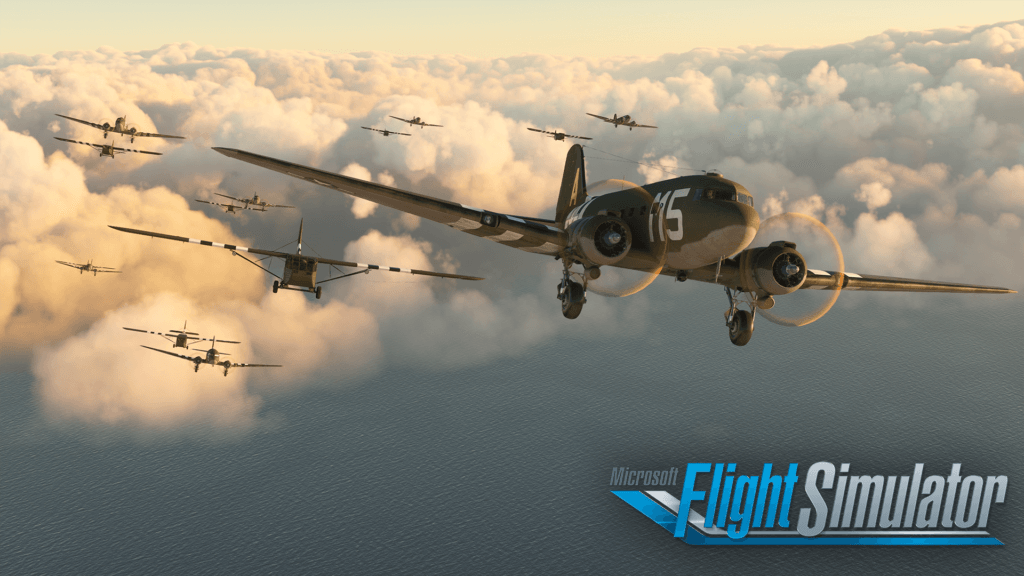D-DAY:
At 1:19 AM on June 6, 1944, the first of 52 C-47 Skytrains of the 434th Troop Carrier Group began roaring into the sky in southern England. Launching from RAF Aldermaston, each Skytrain pulled a Waco CG-4A cargo glider behind a 350-foot-long towline. The 52 gliders were packed full of light artillery systems, anti-tank guns, ammunition, other weapons, a surgical team, and troops. Codenamed “Mission Chicago,” the gliders were bound for “LZ E,” a landing zone just to the west of the French commune Hiesville. Ten minutes later, 52 Skytrains of “Mission Detroit,” each towing a CG-4A, also lifted into the early morning sky.
The two groups were part of Operation Neptune, the initial assault phase of Operation Overlord, the Allied Invasion of Normandy. The first American paratroopers, dropped from low-flying C-47s, had landed on French soil just over an hour earlier, beginning ground operations of D-Day. The contributions of the gliders, far lesser known than other components of the invasion, would prove critical to the allied efforts in the subsequent hours.
THE COMBAT GLIDER:
The use of gliders for combat purposes was a concept first introduced by the German military early in World War II. On May 10, 1940, eleven German assault gliders were towed to an altitude of 8,500 feet by transports for a type of raid never before conducted. They detached from their tethers and flew silently for twenty miles, landing at precise locations just outside a key Belgian fort held by the Allies. The heavily defended fort was considered impregnable. The 78 troops onboard the gliders took control of the compound within just twenty minutes. The success was due almost entirely to the swift, surprise, and precise tactical positioning of troops that was enabled using gliders.
The American military took notice of the novel concept and its stunning success it engendered. Advantages of gliders included the large payload they could carry (roughly 4,000 pounds in the case of the CG-4A), silent operation prior to landing, and ability to land precisely where needed. American planners realized that these operational attributes would complement other forms of military maneuver practices, notably paratroop insertions. General Hap Arnold, the commander of the United States Army Air Forces, established a fresh command dedicated to creating and operating combat gliders in February of 1941. Industry participants submitted several designs that the American military extensively tested. The CG-4A, developed by American aviation firm Waco Aircraft Company, stood above all others in capability.
THE WACO CG-4A:
The CG-4A took its maiden flight in May of 1942 and was introduced into combat service in July of 1943. The CG-4A (CG stands for “Cargo Glider,” although it was often referenced as a “Combat Glider”) played critical roles in several battles. Nearly 14,000 CG-4A gliders were manufactured by over a dozen companies during the Second World War, including by the Ford Motor Company, the Waco Aircraft Company, and the Cessna Aircraft Company.
The high-wing monoplane design comprised a welded steel fuselage frame covered in canvas. Its wings, tail, and control surfaces were built of wood frames covered in fabric, and the glider’s floor was built of honeycombed plywood that could withstand heavy loads and rough landings.
Its nose, which held the cockpit, could swing upward for quick loading and unloading of the main cargo area. Crewed by two, it could carry up to 15 passengers with combat loads, although it typically carried a maximum of 13. With a cargo capacity of just over 4,000 pounds, it could also carry: a 75mm howitzer, 25 rounds of ammunition, and two artillerymen; a Jeep with driver and an assortment of personnel and cargo; a small bulldozer with operator; and several specialty loads including a field kitchen, field hospital, and repair facilities.
The CG-4A measured 48 feet, 8 inches in length, stood 15 feet, 4 inches tall, and had a wingspan of 83 feet, 8 inches. Primary controls consisted of a wheel for pitch and roll inputs, and rudder pedals for yaw. Its instruments included an airspeed indicator, an altimeter, a variometer, a compass, and a turn-and-bank indicator.
The CG-4A had a maximum speed of 150 miles per hour, but it typically “cruised” (towed behind the tug craft) between 110 and 130 mph. During its operational tenure, the CG-4A was towed primarily by the Douglas C-47 Skytrain.
THE DOUGLAS C-47D SKYTRAIN:
The C-47D Skytrain is a low-wing, twin-engine, piston-powered military transport airplane built by the Douglas Aircraft Company of the United States. The Skytrain, which took its maiden flight on December 23, 1941, was based on the company’s successful DC-3 airliner, which was developed and entered service in the 1930s. The Skytrain proved to be one of the most important aircraft for the Allies during World War II. One of its most important roles was as a tug aircraft for Waco CG-4A cargo gliders. The Skytrain could tow the CG-4A either from a standstill on the ground or by performing a “glider snatch pick-up,” snaring the glider’s tow line while flying just above ground level.
In the late 1930s, the United States Army Air Forces sought a transport aircraft that was more capacious, faster, and had a longer range than the military variants of the Douglas DC-2, the C-32, the C-33, and the C-34. In 1941, the command chose the DC-3 (developed from the DC-2) as the basis for their new primary transport aircraft, designating it the C-47 Skytrain. The all-metal DC-3 (Douglas Commercial 3), introduced as an airliner in 1936, proved efficient, reliable, fast, and was renowned for having great range.
The DC-3 required only a few modifications for the Army’s needs. These changes included the addition of a large cargo door, a strengthened floor in the fuselage, and glider tow hooks on its tail section that would be used for towing the Waco CG-4A.
The C-47 was crewed by three or four, depending on mission requirements, and could carry up to 28 fully equipped troops, 6,000 pounds of cargo, or some combination. A total of 10,000 Skytrains were produced by the end of World War II. The airframe served several roles other than glider towing, including general transport, paratroop delivery, medical evacuation, gunship, and reconnaissance.
All branches of the U.S. military used the Skytrain during World War II, as did every major Allied power. The British and Australians called it the Dakota (Douglas Aircraft Company Transport Aircraft).
The C-47 proved vital for the Allied victory. It operated in every major battle of the war, ensuring personnel, weapons, food, fuel, and other materiel arrived at the right places at the right times. This included delivering thousands of paratroops during the Battle of Normandy and flying the infamous “hump” over the Himalaya mountains from India to China, one of the most demanding, and dangerous, airlift missions in history. Post-World War II, the Skytrain played critical roles in the Berlin Air Lift, the Korean War, and the Vietnam War. Many, converted for civil use, continue to operate today around the world. Over 100 countries have used the C-47.
The C-47 measures 63 feet, 9 inches in length, has a wingspan of 95 feet, 6 inches, and stands 17 feet tall. It features a swept main wing, a standard tail unit, and a retractable traditional undercarriage. It is powered by two wing-mounted 14-cylinder Pratt & Whitney R-1830-90C Twin Wasp radial engines that each produce up to 1,200 horsepower and turn 3-blade, constant-speed propellers. It has a maximum range of 3,800 miles, a normal range of 1,600 miles, climbs at 1,000 feet per minute, and has a service ceiling of 26,400 feet above sea level. The C-47 cruises at 160 miles per hour and has a maximum speed of 224 mph.
CG-4A AVIATORS AND THEIR MISSIONS:
“Every landing was a genuine do-or-die situation for the glider pilots. It was their awesome responsibility to repeatedly risk their lives by landing heavily laden aircraft containing combat soldiers and equipment in unfamiliar fields deep within enemy-held territory, often in total darkness. They were the only aviators during World War II who had no motors, no parachutes, and no second chances.” – United States Army General William Westmoreland, discussing the pilots of military cargo gliders.
After releasing the tow line from the C-47, the CG-4A pilot needed to navigate to a landing zone, keeping the aircraft above its stall speed of 49 miles per hour. The CG-4A could land in just 200 yards, granted it touched down at its ideal landing speed of 60 miles per hour. Once on the ground, the pilots helped unload the glider’s personnel and contents and then grabbed their weapons and joined the troops they carried into combat.
Landing the CG-4A was incredibly dangerous. Pilots had only one shot. Adding to the danger was a German innovation, “Rommelspargel,” the dreaded “Rommel’s Asparagus.” Devised by German Field Marshal Erwin Rommel, these were wooden poles, some as tall as 16 feet, placed throughout open fields in Normandy. Intended to interdict American gliders and paratroopers, many of them were topped with explosives.
D-DAY VICTORY:
As the aircraft of Mission Chicago approached LZ E just before 4:00 AM on D-Day, German anti-aircraft fire erupted. One of the C-47s was shot down. The lead C-47, guided by a radio beacon placed by a pathfinder prior to their arrival, released its glider. The other Skytrains of Mission Chicago followed, then the Skytrains and CG-4As of Mission Detroit arrived. The pre-dawn glider missions, as well as those undertaken later in D-Day, were a resounding success. The gliders delivered critical supplies to Allied troops, helping secure a D-Day Victory.
RELIVE THE ADVENTURE IN MICROSOFT FLIGHT SIMULATOR:
Both the Douglas C-47 and the Waco CG-4A have been expertly recreated for flight simulator aviators to experience.
The Waco CG-4A comes with one livery: Olive Drab. The Douglas C-47D Skytrain comes with two liveries: Olive Drab “M5” (Fictional) and U.S. Navy. Buy the aircraft bundle today for $14.99. For every purchase of the Famous Flyer 9 pack made between June 6, 2024 and July 5, 2024, Microsoft will donate 100% of each sale to the USO (https://www.uso.org/). More information about the USO is available by contacting them at info@uso.org. The sky is calling!
Microsoft Flight Simulator is available for Xbox Series X|S and PC with Xbox Game Pass, PC Game Pass, Windows, and Steam, and on Xbox One and supported mobile phones, tablets, and lower-spec PCs via Xbox Cloud Gaming. For the latest information on Microsoft Flight Simulator, stay tuned to @MSFSOfficial on Twitter.

